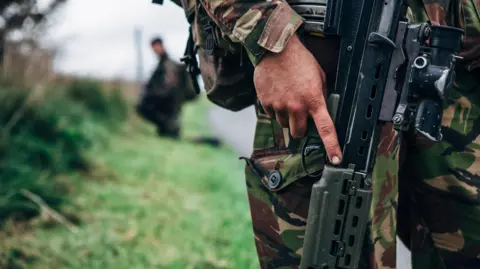Through Frank Gardner, bbc security correspondent
 getty pictures
getty picturesPrime Minister Sir Keir Starmer has launched a “root and branch review” of the military to help prepare the United Kingdom for a “more dangerous and unstable world”.
The federal government said the strategic defense assessment would envisage the force surrounding it, the ultimatums facing the United Kingdom and the facilities required to deal with them.
Sir Keir previously said the assessment would serve as a “roadmap” to achieve the target of spending 2.5% of national revenue sources on defense – a target he has made “Cast Iron” Loyalty However, a timeline has yet to be determined.
The assessment will seek submissions from the military, veterans, parliamentarians, defense industry, the public, teachers and allies of the United Kingdom by the end of September and will aim to bring forward its findings within the first half of 2025.
Sir Keir said, “I promised the British people that I would bring about the change we need to take our country forward, and I promised actions, not words.”
“That is why one of my first tasks since taking office is to launch our strategic defense review.
“We will ensure that our lost armed forces are strengthened and honoured, defense spending is increased responsibly, and that our country has the capabilities it needs to ensure UK resilience for the long term.”
The review will be overseen by Defense Secretary John Healey and chaired by former NATO Secretary General Lord Robertson, along with former US presidential adviser Fiona Hill and former Joint Force Commander General Sir Richard Barons.
The group will finish its work.
The global security threats facing Britain and its Western allies are graver and more complex than at any time since the end of the Cold War in 1990.
They also coincide with what many commentators have said is the catastrophic decline of Britain’s armed forces to such an extent that the country is no longer considered a definitive tier one military force.
In terms of the number of soldiers in its regular army, the British Army is now at its smallest size since the Napoleonic Wars two centuries ago.
Recruits are failing to keep up with retention, with many soldiers and officers complaining of neglect and substandard housing.
The Royal Navy, which has spent huge sums on its two centerpiece aircraft carriers, needs many more surface ships to carry out its operations around the world.
The aging fleet of nuclear-armed Vanguard submarines, the cornerstone of the UK’s strategic defense and known as the Continuous At Sea Deterrent (CASD), is overdue for replacement of the four Dreadnought-class submarines and costs are rising .
Commenting on the review, Mr Healey said: “Hollowed armed forces, procurement waste and neglected morale cannot continue.”
Too much UK continuity?
The UK, NATO and its allies face many defense and security threats.
These include the ongoing war in eastern Europe in Ukraine against Russia’s full-scale invasion. Britain, along with the EU and NATO, has opted to help defend Ukraine with a multibillion-pound package of arms and aid, preventing a drawdown of combat troops.
The policy behind this is not entirely altruistic. European governments, especially those closest to Russia such as Poland and the Baltic states, fear that if President Putin wins the war in Ukraine it will not take long for him to rebuild his forces and launch another invasion.
Some of those countries are already busy increasing their own defense spending to closer to 3% or 4% of GDP.
The challenge for NATO is how to provide Ukraine with as many weapons as possible without provoking Russia into retaliating against a NATO state and risking provoking a Third World War.
The Royal Navy has recently been in action in the Red Sea, where it is working with the US Navy to prevent attacks on shipping by Iranian-backed Houthi rebels in Yemen.
But Britain has also made naval commitments in the South China Sea with the AUKUS agreement, which involves Australia, Britain and the US, aimed at deterring Chinese expansion in the region.
Critics have questioned whether financially strapped Britain can make such commitments on the other side of the world.
Closer to home in Europe, the threat of so-called “hybrid warfare” attacks, which are suspected to come from Russia, is increasing.
These are anonymous, untraceable attacks on the undersea pipelines and telecommunications cables on which Western countries depend.
As tensions with Moscow increase, there are fears that such actions will increase and the UK cannot possibly expect to defend all of its coastline at all times.
But while nervous NATO partners close to Russia’s borders are busy boosting their defense spending to closer to 3 or 4% of GDP, Britain has so far refused to put a timetable on how it will raise its defense spending. When will he increase the expenditure by only 2.5%? ,
Opposition figures have criticized the government for refusing to say when defense spending will be increased.
Before his election defeat, former Prime Minister Rishi Sunak is committed to reach 2.5% by 2030.
Shadow Defense Secretary James Cartlidge previously said: “On an international scale this is more risky and dangerous than any week since the Cold War, with Keir Starmer’s Labor Executive having to spend 2.5% of GDP There was a vague alternative to the Conservatives’ fully funded term for defense until 2030.
“By failing to act, they have created a severe lack of certainty for our military, in the worst week imaginable.”
Discover more from news2source
Subscribe to get the latest posts sent to your email.




